2002 MERCEDES-BENZ G500 four wheel drive
[x] Cancel search: four wheel drivePage 6 of 385

3 Contents
DrivingControl and operation of
radio transmitters ..................... 190
The first 1 000 miles
(1 500 km) ................................. 191
Maintenance ................................... 191
Tele Aid ........................................... 192
Catalytic converter ........................202
Emission control ............................203
Starter switch .................................204
Starting and turning off
the engine ..................................206
Automatic transmission ...............207
Parking brake ................................. 215Driving instructions ....................... 216
Drive sensibly – save fuel ......... 216
Drinking and driving ................. 216
Pedals ........................................... 216
Power assistance .........................217
Brakes ...........................................217
Driving off ....................................218
Parking ......................................... 219
Tires .............................................. 219
Snow chains ............................... 222
Winter driving instructions ..... 222
Deep water .................................. 224
Passenger compartment ........... 225
Traveling abroad ........................ 225
Off-Road driving ............................ 226
Cruise control ................................ 234
Brake assist system
(BAS) .......................................... 237Antilock brake system
(ABS) ...........................................239
Four-wheel electronic traction system
(4-ETS) ........................................ 241
Electronic Brake Booster
(EBB) ...........................................242
Electronic stability program
(ESP) ...........................................243
Transfer case ..................................247
Switching transfer case .............248
A few words about differentials
and differential locks ............... 251
Differential locks ............................253
What you should know
at the gas station .......................258
Check regularly and before a long
trip ............................................... 261
J_G463.book Seite 3 Mittwoch, 19. September 2001 8:06 08
Page 192 of 385
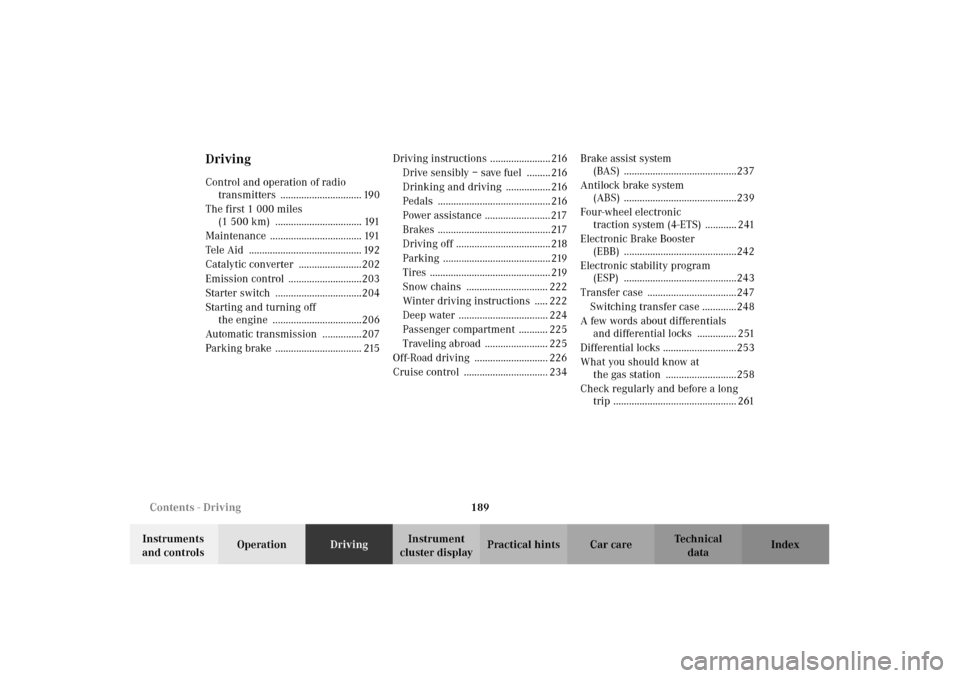
189 Contents - Driving
Te ch n i c a l
data Instruments
and controlsOperationDrivingInstrument
cluster displayPractical hints Car care Index
DrivingControl and operation of radio
transmitters ............................... 190
The first 1 000 miles
(1 500 km) ................................. 191
Maintenance ................................... 191
Tele Aid ........................................... 192
Catalytic converter ........................202
Emission control ............................203
Starter switch .................................204
Starting and turning off
the engine ..................................206
Automatic transmission ...............207
Parking brake ................................. 215Driving instructions ....................... 216
Drive sensibly – save fuel ......... 216
Drinking and driving ................. 216
Pedals ........................................... 216
Power assistance .........................217
Brakes ...........................................217
Driving off ....................................218
Parking ......................................... 219
Tires .............................................. 219
Snow chains ............................... 222
Winter driving instructions ..... 222
Deep water .................................. 224
Passenger compartment ........... 225
Traveling abroad ........................ 225
Off-Road driving ............................ 226
Cruise control ................................ 234Brake assist system
(BAS) ...........................................237
Antilock brake system
(ABS) ...........................................239
Four-wheel electronic
traction system (4-ETS) ............ 241
Electronic Brake Booster
(EBB) ...........................................242
Electronic stability program
(ESP) ...........................................243
Transfer case ..................................247
Switching transfer case .............248
A few words about differentials
and differential locks ............... 251
Differential locks ............................253
What you should know at
the gas station ...........................258
Check regularly and before a long
trip ............................................... 261
J_G463.book Seite 189 Mittwoch, 19. September 2001 8:06 08
Page 224 of 385
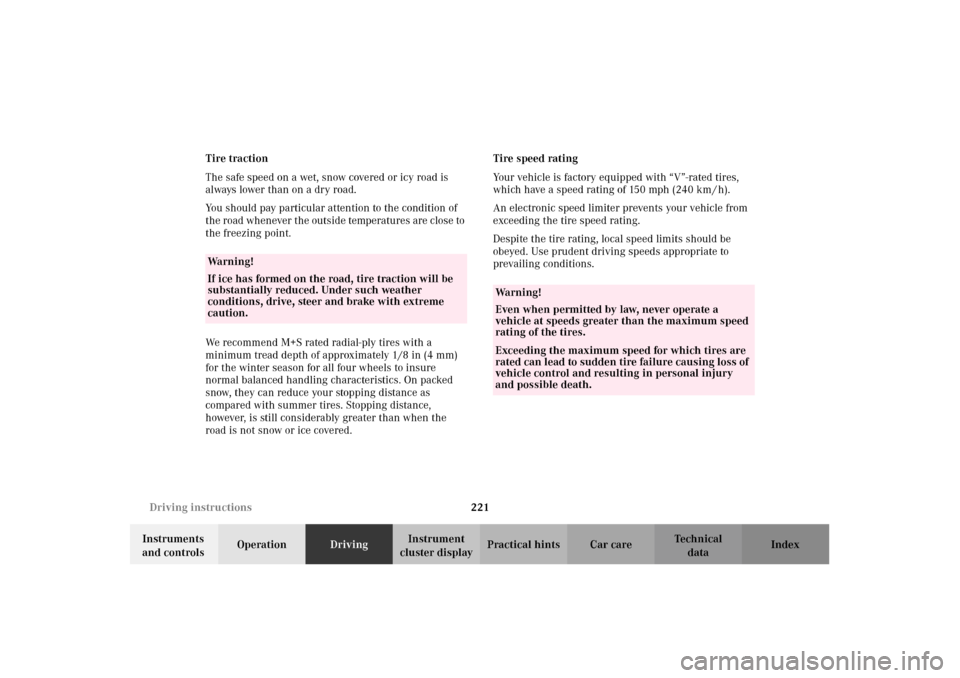
221 Driving instructions
Te ch n i c a l
data Instruments
and controlsOperationDrivingInstrument
cluster displayPractical hints Car care Index Tire traction
The safe speed on a wet, snow covered or icy road is
always lower than on a dry road.
You should pay particular attention to the condition of
the road whenever the outside temperatures are close to
the freezing point.
We recommend M+S rated radial-ply tires with a
minimum tread depth of approximately 1/8 in (4 mm)
for the winter season for all four wheels to insure
normal balanced handling characteristics. On packed
snow, they can reduce your stopping distance as
compared with summer tires. Stopping distance,
however, is still considerably greater than when the
road is not snow or ice covered.Tire speed rating
Your vehicle is factory equipped with “V”-rated tires,
which have a speed rating of 150 mph (240 km / h).
An electronic speed limiter prevents your vehicle from
exceeding the tire speed rating.
Despite the tire rating, local speed limits should be
obeyed. Use prudent driving speeds appropriate to
prevailing conditions.
Wa r n i n g !
If ice has formed on the road, tire traction will be
substantially reduced. Under such weather
conditions, drive, steer and brake with extreme
caution.
Wa r n i n g !
Even when permitted by law, never operate a
vehicle at speeds greater than the maximum speed
rating of the tires.Exceeding the maximum speed for which tires are
rated can lead to sudden tire failure causing loss of
vehicle control and resulting in personal injury
and possible death.
J_G463.book Seite 221 Mittwoch, 19. September 2001 8:06 08
Page 225 of 385
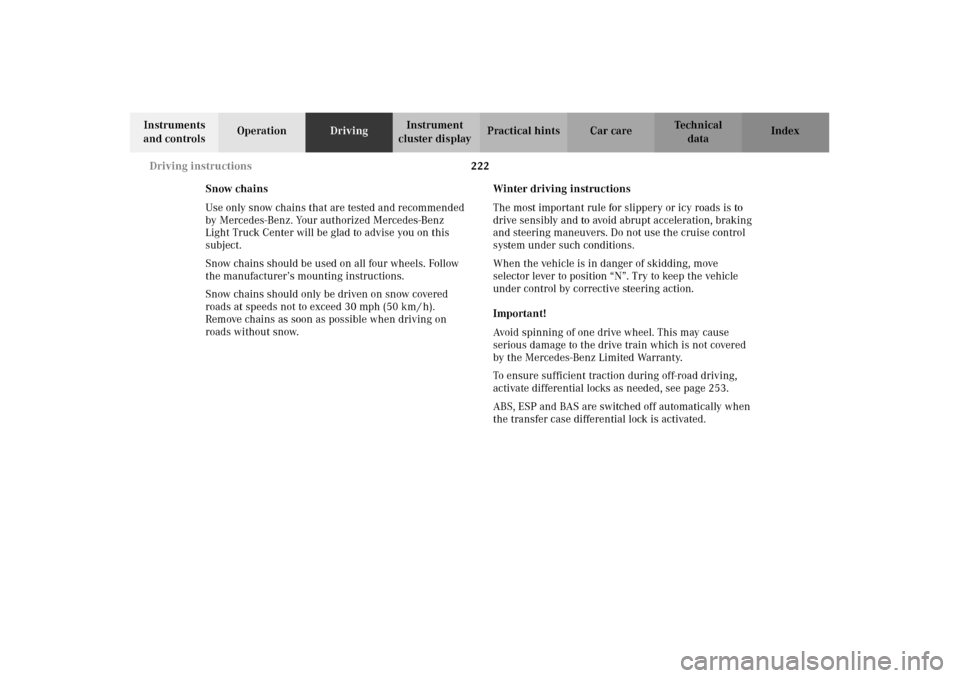
222 Driving instructions
Te ch n i c a l
data Instruments
and controlsOperationDrivingInstrument
cluster displayPractical hints Car care Index
Snow chains
Use only snow chains that are tested and recommended
by Mercedes-Benz. Your authorized Mercedes-Benz
Light Truck Center will be glad to advise you on this
subject.
Snow chains should be used on all four wheels. Follow
the manufacturer’s mounting instructions.
Snow chains should only be driven on snow covered
roads at speeds not to exceed 30 mph (50 km / h).
Remove chains as soon as possible when driving on
roads without snow.Winter driving instructions
The most important rule for slippery or icy roads is to
drive sensibly and to avoid abrupt acceleration, braking
and steering maneuvers. Do not use the cruise control
system under such conditions.
When the vehicle is in danger of skidding, move
selector lever to position “N”. Try to keep the vehicle
under control by corrective steering action.
Important!
Avoid spinning of one drive wheel. This may cause
serious damage to the drive train which is not covered
by the Mercedes-Benz Limited Warranty.
To ensure sufficient traction during off-road driving,
activate differential locks as needed, see page 253.
ABS, ESP and BAS are switched off automatically when
the transfer case differential lock is activated.
J_G463.book Seite 222 Mittwoch, 19. September 2001 8:06 08
Page 226 of 385
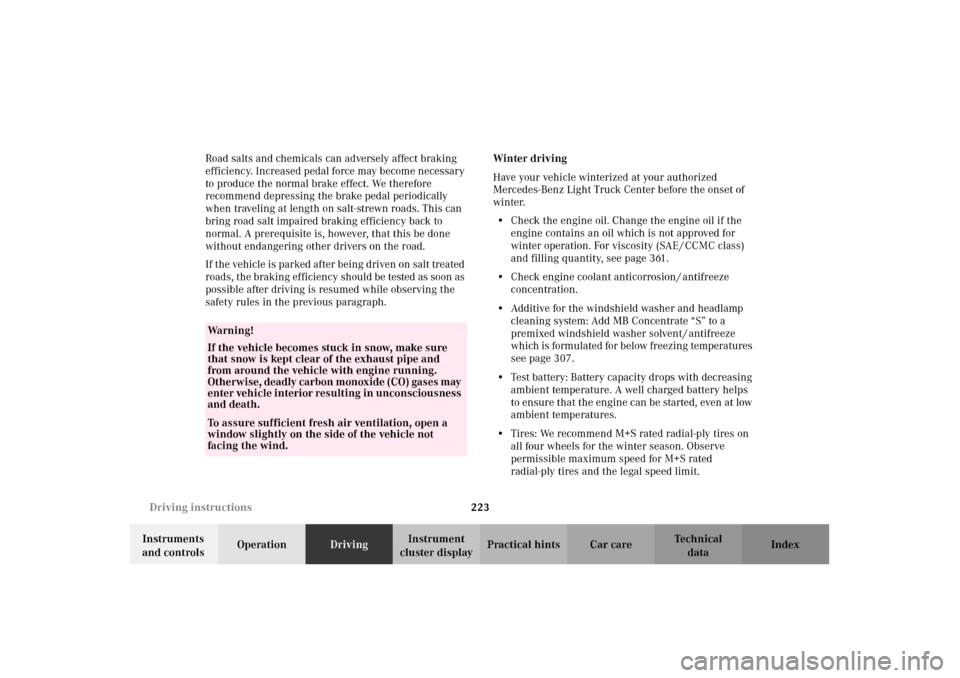
223 Driving instructions
Te ch n i c a l
data Instruments
and controlsOperationDrivingInstrument
cluster displayPractical hints Car care Index Road salts and chemicals can adversely affect braking
efficiency. Increased pedal force may become necessary
to produce the normal brake effect. We therefore
recommend depressing the brake pedal periodically
when traveling at length on salt-strewn roads. This can
bring road salt impaired braking efficiency back to
normal. A prerequisite is, however, that this be done
without endangering other drivers on the road.
If the vehicle is parked after being driven on salt treated
roads, the braking ef ficiency should be tested as soon as
possible after driving is resumed while observing the
safety rules in the previous paragraph.Winter driving
Have your vehicle winterized at your authorized
Mercedes-Benz Light Truck Center before the onset of
winter.
•Check the engine oil. Change the engine oil if the
engine contains an oil which is not approved for
winter operation. For viscosity (SAE / CCMC class)
and filling quantity, see page 361.
•Check engine coolant anticorrosion / antifreeze
concentration.
•Additive for the windshield washer and headlamp
cleaning system: Add MB Concentrate “S” to a
premixed windshield washer solvent / antifreeze
which is form ulated for b elow f r eezin g temperatures
see page 307.
•Test battery: Battery capacity drops with decreasing
ambient temperature. A well charged battery helps
to ensure that the engine can be started, even at low
ambient temperatures.
•Tires: We recommend M+S rated radial-ply tires on
all four wheels for the winter season. Observe
permissible maximum speed for M+S rated
radial-ply tires and the legal speed limit.
Wa r n i n g !
If the vehicle becomes stuck in snow, make sure
that snow is kept clear of the exhaust pipe and
from around the vehicle with engine running.
Otherwise, deadly carbon monoxide (CO) gases may
enter vehicle interior resulting in unconsciousness
and death.To assure sufficient fresh air ventilation, open a
window slightly on the side of the vehicle not
facing the wind.
J_G463.book Seite 223 Mittwoch, 19. September 2001 8:06 08
Page 227 of 385
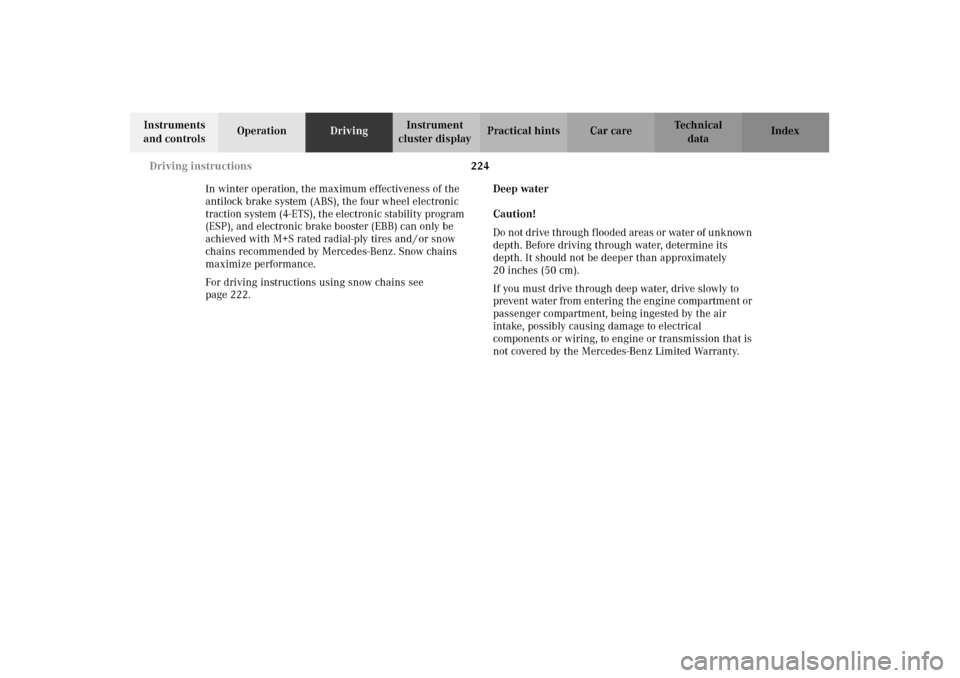
224 Driving instructions
Te ch n i c a l
data Instruments
and controlsOperationDrivingInstrument
cluster displayPractical hints Car care Index
In winter operation, the maximum effectiveness of the
antilock brake system (ABS), the four wheel electronic
traction system (4-ETS), the electronic stability program
(ESP), and electronic brake booster (EBB) can only be
achieved with M+S rated radial-ply tires and / or snow
chains recommended by Mercedes-Benz. Snow chains
maximize performance.
For driving instructions using snow chains see
page 222.Deep water
Caution!
Do not drive through flooded areas or water of unknown
depth. Before driving through water, determine its
depth. It should not be deeper than approximately
20 inches (50 cm).
If you must drive through deep water, drive slowly to
prevent water from entering the engine compartment or
passenger compartment, being ingested by the air
intake, possibly causing damage to electrical
components or wiring, to engine or transmission that is
not covered by the Mercedes-Benz Limited Warranty.
J_G463.book Seite 224 Mittwoch, 19. September 2001 8:06 08
Page 232 of 385
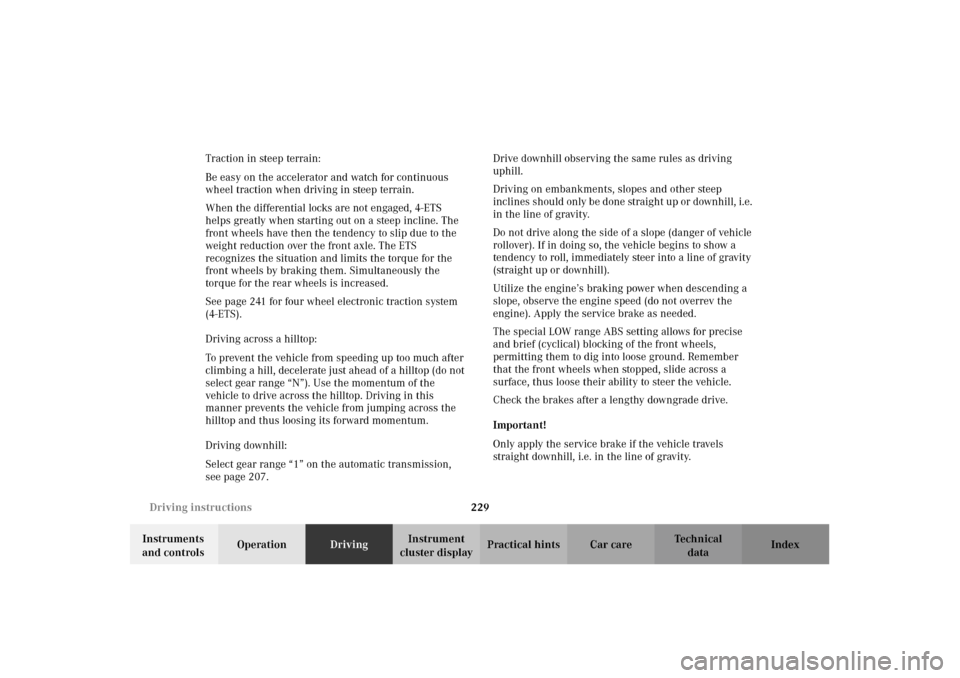
229 Driving instructions
Te ch n i c a l
data Instruments
and controlsOperationDrivingInstrument
cluster displayPractical hints Car care Index Traction in steep terrain:
Be easy on the accelerator and watch for continuous
wheel traction when driving in steep terrain.
When the differential locks are not engaged, 4-ETS
helps greatly when starting out on a steep incline. The
front wheels have then the tendency to slip due to the
weight reduction over the front axle. The ETS
recognizes the situation and limits the torque for the
front wheels by braking them. Simultaneously the
torque for the rear wheels is increased.
See page 241 for four wheel electronic traction system
(4-ETS).
Driving across a hilltop:
To prevent the vehicle from speeding up too much after
climbing a hill, decelerate just ahead of a hilltop (do not
select gear range “N”). Use the momentum of the
vehicle to drive across the hilltop. Driving in this
manner prevents the vehicle from jumping across the
hilltop and thus loosing its forward momentum.
Driving downhill:
Select gear range “1” on the automatic transmission,
see page 207.Drive downhill observing the same rules as driving
uphill.
Driving on embankments, slopes and other steep
inclines should only be done straight up or downhill, i.e.
in the line of gravity.
Do not drive along the side of a slope (danger of vehicle
rollover). If in doing so, the vehicle begins to show a
tendency to roll, immediately steer into a line of gravity
(straight up or downhill).
Utilize the engine’s braking power when descending a
slope, observe the engine speed (do not overrev the
engine). Apply the service brake as needed.
The special LOW range ABS setting allows for precise
and brief (cyclical) blocking of the front wheels,
permitting them to dig into loose ground. Remember
that the front wheels when stopped, slide across a
surface, thus loose their ability to steer the vehicle.
Check the brakes after a lengthy downgrade drive.
Important!
Only apply the service brake if the vehicle travels
straight downhill, i.e. in the line of gravity.
J_G463.book Seite 229 Mittwoch, 19. September 2001 8:06 08